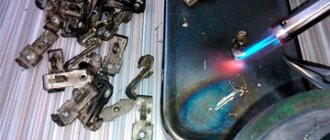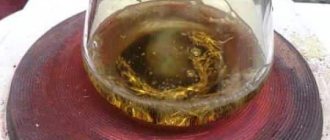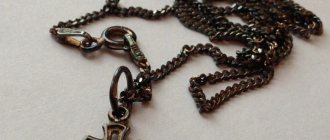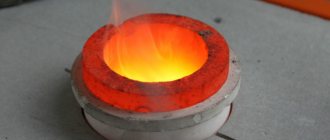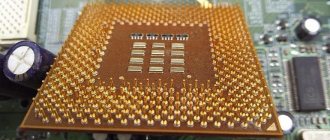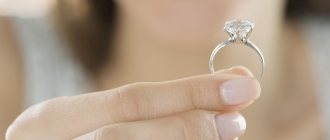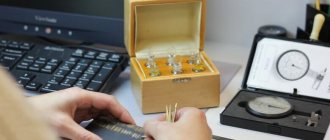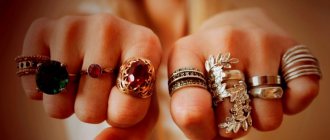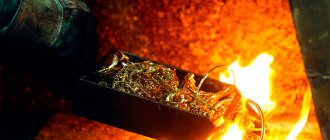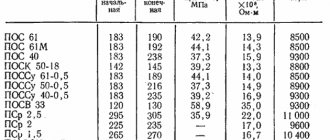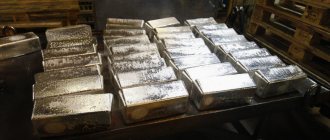Equipment
To start refining both gold and silver in your home workshop, you will need to purchase quite a few tools and consumables.
Here is a list of the essentials:
- beakers per liter and 250 ml;
- laboratory funnel for transferring liquids;
- glass stick (at least 30 cm long);
- crucibles for melting;
- electric stove;
- thick rubber gloves;
- respirator with carbon filter;
- protective glasses;
- porcelain bowls for chemicals.
Gold refining using iron sulfate
Refining gold, and to no less extent silver, in a similar way requires the preliminary production of chlorides of these metals. This process is quite complicated and requires a distillation cube.
The process looks like this:
- raw materials are ground into powder;
- placed in a sealed chamber;
- chlorine gas is driven through it;
- the solution is condensed.
If a composition containing silver was used as the starting material, then the liquid will have to be heated - in this case, the mentioned metal associated with chlorine collects on the surface, and the gold itself and other impurities end up at the bottom.
Many people then complete the refining process by electrolysis. Gold chloride is dissolved in hydrochloric acid and poured into the bath. Two metal objects connected to electricity are also placed there. As a result, the precious metal is deposited on what is connected to the battery positive.
If there is no equipment for electrolysis, then iron sulfate should be used. The powder must be dissolved in water in a ratio of 1 to 2. For one gram of raw material, 12 ml of the composition will be required. If the reagent becomes cloudy, immerse ordinary nails in it (no more than 5 g per 100 ml).
Before starting the cleaning, the previously obtained gold chloride is mixed with aqua regia and ordinary table salt (take the “Extra” type). The mixture is heated (stirring) in a porcelain container, placing an asbestos gasket between it and the flame. Our task is to eliminate excess nitric acid. The process is considered complete when the substance thickens to the state of sugar syrup. A solution of iron sulfate is poured into the prepared preparation. After shaking, a brown precipitate forms. His:
- filter;
- washed;
- dried;
- burn together with the paper filter;
- all that remains will be gold.
Jeweler services as a reliable and safe way to verify the authenticity of metal
Traditional methods of metal testing are good as an express method. For reliability and confidence in the results, you should contact a professional jeweler. In his arsenal there will be all the necessary means of determining the authenticity of a gold product.
The jeweler always has the necessary tools at hand to test precious metals.
Refining gold directly with iodine
This method allows you to refining gold from the found stone. The process itself is quite labor-intensive and does not guarantee success, since the presence of precious metal in a piece of rock is very difficult to determine by eye.
The procedure is as follows:
- the ore is crushed to a homogeneous powder;
- it is washed in a tray until black grains (concentrate) remain;
- the residue is dried and placed in a test tube;
- 10 percent alcohol iodine is also poured in (for 2 grams - 6 ml);
- the mixture is heated for 10 minutes, without allowing it to boil;
- leave until sediment settles;
- the clear solution is collected into a pipette;
- squeeze out drop by drop (as the previous one dries) onto the heated glass.
As a result, if there really was gold in the stone, then a so-called mirror will remain on the plate. It must be washed in nitric acid to remove unnecessary metals. All that remains as a result will be the desired precious metal.
Working with chemicals in a chemical laboratory
Content
Working with chemicals Working with acids and alkalis Working with flammable liquids (flammable liquids) Working with mercury salts Working with solids
Working with chemicals |
1. When working with chemical reagents, there must be at least two employees in the laboratory.
2. When starting work, employees are required to inspect and put their workplace in order, free it from items unnecessary for work.
3. Before work, it is necessary to check the serviceability of the equipment, the presence of grounding, etc.
4. Work with caustic and toxic substances, as well as organic solvents, is carried out only in fume hoods.
5. It is prohibited to draw reagents into pipettes by mouth; a rubber bulb or other device should be used for this purpose.
6. When determining the smell of chemicals, you should sniff carefully, directing the vapors or gases towards you with a movement of your hand.
7. Work that may result in increased pressure, overheating of a glass device or its breakage with splashing of hot or caustic products is also carried out in fume hoods. The worker must wear safety glasses (mask), gloves and an apron.
8. When working in a fume hood, the cabinet doors should be raised to a height of no more than 20 - 30 cm so that only hands are in the cabinet, and the progress of the process should be monitored through the cabinet glass.
9. When working with chemical reagents, it is necessary to turn on and off the exhaust ventilation at least 30 minutes before starting and after finishing work.
10. Mixing or diluting chemicals that generate heat should be done in heat-resistant or porcelain containers.
11. When evaporating solutions in glasses, they should be thoroughly mixed, since the lower and upper layers of solutions have different densities, as a result of which liquid may be ejected.
12. To avoid burns, splashes, and blowouts, do not lean over cookware that contains boiling liquids.
13. Heating dishes made of ordinary glass over an open fire without an asbestos mesh is prohibited.
14. When heating a liquid in a test tube, you should hold it with the opening away from you and other employees.
15. Under no circumstances should liquids be allowed to heat in flasks or devices that are not exposed to the atmosphere.
16. A heated vessel cannot be closed with a ground-in stopper until it has cooled to ambient temperature.
Return to content
Working with acids and alkalis |
1. Work with concentrated acids and alkalis is carried out only in a fume hood and using protective equipment (gloves, goggles). When working with fuming nitric acid with a specific density of 1.51 - 1.52 g/cm3, you should also wear a rubber apron.
2. Concentrated nitric, sulfuric and hydrochloric acids used for work must be stored in a fume hood in glass containers with a capacity of no more than 2 dm3. The presence of flammable substances in acid storage areas is prohibited.
Dilute solutions of acids (with the exception of hydrofluoric acid) are also stored in glass containers, and alkalis - in plastic containers.
3. Working with hydrofluoric acid requires special care and must be carried out in a fume hood. Hydrofluoric acid must be stored in polyethylene containers.
4. Carrying bottles with acids is allowed only by two people and only in baskets, the gaps in which are filled with shavings or straw. Smaller containers with concentrated acids and alkalis should be carried in containers that protect against burns (special boxes with a handle).
5. Concentrated acids, alkalis and other caustic liquids should be poured using special bulb siphons or other pressure means.
6. To prepare solutions of sulfuric, nitric and other acids, they must be poured into water in a thin stream with continuous stirring. For this, heat-resistant dishes are used, since the dissolution process is accompanied by strong heating.
It is prohibited to add water to acids!
7. If acid gets on the skin, the affected area should be immediately rinsed for 10 - 15 minutes with a fast stream of water, and then neutralized with a 2 - 5% sodium carbonate solution.
8. Spilled acid should be covered with sand. After cleaning the sand, the area where the acid was spilled is sprinkled with lime or soda and then washed with water.
9. Spilled concentrated solutions of caustic soda, caustic potassium and ammonia can be covered with both sand and sawdust, and after removing them, treat the area with a weak solution of acetic acid.
10. Used chemical utensils and devices containing acids, alkalis and other caustic substances must be freed from residues and rinsed with tap water before being washed.
Return to content
Working with flammable liquids (flammable liquids) |
1. Before working with flammable liquids, it is necessary to check the availability and prepare primary fire extinguishing means for use.
2. It is prohibited to carry out any work with flammable liquids outside the fume hood!
3. Distillation and heating of low-boiling flammable liquids should be carried out in round-bottomed flasks installed in baths filled with an appropriate coolant (water, oil, sand). To heat baths, use electric stoves only with closed heating elements.
It is prohibited to distill flammable liquids on tiles with an open spiral!
4. When distilling flammable liquids, it is necessary to constantly monitor the operation of the refrigerator.
5. It is prohibited to heat substances in water baths that may react with water causing an explosion or the release of gases.
6. Laboratory installations in which flammable liquids were heated may be disassembled only after they have cooled to room temperature.
7. In the event of a spill or ignition of flammable liquid, it is necessary to turn off all electric heating devices, and, if necessary, turn off the power to the laboratory. The area where the flammable liquid is spilled should be covered with dry sand, and then collected with a wooden or plastic scoop. The use of metal scoops is prohibited.
8. It is necessary to strictly ensure that containers with flammable liquids are not near heated objects and are not illuminated by direct sunlight, because Pressure builds up inside the hermetically sealed container, which can cause the glass bottle to break.
9. When filling glass bottles with flammable liquids “under the cork”, when the temperature rises by 5 - 10 degrees, the bottle may collapse. To prevent this, flammable liquids are not added to the bottles by approximately 10%.
10. Peroxide compounds require the same care in handling as other flammable substances. When working with them, it is unacceptable to heat peroxides above their decomposition temperature.
11. A prerequisite for working with peroxide compounds is to maintain the cleanliness of the workplace, equipment and utensils.
12. To extinguish organic peroxides, water should be used; for inorganic peroxides, dry sand, powder compounds and carbon dioxide fire extinguishers should be used.
Return to content
| Hg | Working with mercury salts |
1. Work with small mercury devices, in which the mercury is well isolated, may be carried out in general laboratory premises on specially designated and appropriately equipped tables.
2. Storing unused and damaged mercury equipment in work areas is prohibited.
3. You should be extremely careful when working with mercury salts. Divalent mercury salts are especially dangerous.
4. Spilled mercury is collected mechanically using a pipette with a bulb or a copper (tinned) plate, then the contaminated surface is covered with elemental sulfur or washed with bleach or a 1% solution of potassium permanganate acidified with hydrochloric acid (5 cm3 HCl per 1 dm3 1% KMnO4 solution) .
5. For better cleaning of mercury, after washing with a chrome mixture and thoroughly rinsing, dishes should be washed with a 2.5% solution of iodine in a 30% solution of potassium iodide.
6. Spent mercury is stored under a layer of dehydrated kerosene.
It is prohibited to pour mercury into the sewer!
7. After working with mercury, you should wash your hands thoroughly with warm water and soap.
Return to content
Handling solids |
1. All dry reagents must be taken with porcelain spoons and spatulas.
It is prohibited to take reagents with unprotected hands!
2. When weighing solids, you should always use some kind of container. It is unacceptable to pour substances directly onto the scale pan.
3. Work with toxic and harmful solids should only be carried out in a fume hood and with all safety precautions.
4. Care must be taken when mixing solids (especially organic) as the resulting dust may be explosive. It is prohibited to mix dry reagents near switched on electric heating devices.
5. To prevent their spraying, work with powdery substances should be carried out in places where there are no drafts or strong air movement.
6. A reagent that spills on the table cannot be poured back into the same jar where it is stored.
7. Work with alkali metals should be carried out in a fume hood in a clean and dry place, using minimal quantities and using safety glasses and rubber gloves.
To avoid ignition of alkali metals, do not allow water to come into contact with them.
8. Work with flammable reagents away from fire and operating heating devices.
Return to content
Source link
Blog “Laboratory_” on Yandex.Zen, article “ Working with chemicals in a chemical laboratory
«.
How gold is refined from old radio components
Extracting gold from radio components that have become unusable is quite possible at home. The precious metal is contained in:
- transistors;
- microchips;
- even SIM cards.
Let's say right away that quite a lot of raw materials are required to obtain a noticeable result. The thing is that the content of valuable metal in radio components rarely exceeds 1 percent.
Refining gold and, equally, silver is cheapest to carry out using chemical reagents. In the first case, prepare aqua regia, and in the second, only nitric acid will be enough.
To complete the procedure faster, the container with reagents and crowbar is heated to 76 degrees. It is better to use an electric stove, as it allows you to control the temperature as accurately as possible. At home, it is permissible to limit yourself to an enamel pan that has no cracks or scratches. If you don't have one, take an aluminum container.
Before you begin refining, remove the gold-plated elements from the radio components and throw away everything else. It is not difficult to determine exactly where the precious metal is located - these are, as a rule, contacts and other parts that have a characteristic yellow color.
The prepared scrap is placed in a container with already heated acid and kept on the stove for at least 4 hours (or until the liquid has completely evaporated). Remember to stir regularly with a glass rod. Upon completion of the procedure, remove undissolved iron elements using a magnet. The finished powder is dried and melted.
Convenience of the method and its disadvantages
A household method of checking precious metal for authenticity using iodine:
Convenient and easy enough to use.
Does not require complex chemical reagents or special equipment.
It can be carried out by non-specialists; it is enough to carefully observe the reaction of the interaction of two elements.
The disadvantages include:
Checking only the surface part of the jewelry.
It is impossible to obtain a result with 100% accuracy.
It is impossible to check gold-plated products; the top layer of gold will be removed with sandpaper.
Difficulties also arise with rhodium-plated products, if a thin layer of rhodium is removed, a yellowish or reddish metal appears underneath it.

